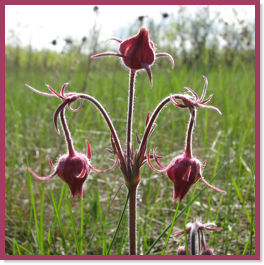
Old Man's Whiskers
| By Shirley Froehlich | (Click links for images.) |

Three-flowered Avens
Imagine yourself walking through a prairie field in early May. It could be a warm spring day, but there isn't much new plant growth visible at this time of year. The vegetation consists mostly of dry, brown grasses from last year. The prairie crocus has mostly finished blooming, although there are still a few flowers here and there. But wait! What is that patch of green over there? Upon closer inspection you find not just one, but many, many patches of bright green leaves hugging the ground and stretching off into the distance. What could they be?
Now, let's go back to the same field in the middle of May. There are hundreds upon hundreds of small pink flowers dancing on the breeze above the clumps of green. WOW! There is nothing like a mass of plants to make an impact.
|
DESCRIPTION
Now that the plants are blooming it is easier to figure out what they are. The reddish- pink nodding flowers are on a stalk 15-45 cm tall (6-18"). They look like they haven't opened yet, but they are actually mature at this stage. Each plant has a number of flower stalks so that even though the individual flowers are only 1-2 cm (1/2"-3/4") across, a group of them looks quite eye-catching, particularly so early in the season. The flowers are in groups of three and this is where they get their name, Three-Flowered Avens (Geum triflorum). The leaves are mostly all basal with a few tufts of leaves halfway up the flower stems. They are 15-20 cm long(6-8") and they tend to stand somewhat upright in spring and under moist conditions. When it is dry the leaves tend to be flat upon the ground.
|
Let's return to that field one more time in early to mid June. It has changed again. The sun has just begun to shine and from a distance there is a layer of pink-tinged silvery smoke hanging over the field. What a beautiful sight! This brings us to another name given to the plant: "Prairie Smoke". If we look more closely at the "smoke" we find that perhaps it looks more like whiskers, "Old Man's Whiskers". These are the seed heads. The seeds with their long feathery styles last until around the end of June, when they become very dry and are dispersed by the wind.
NATIVE HABITAT
Three Flowered Avens occurs across southern Manitoba, Saskatchewan and Alberta. It grows on the open prairie and hillsides and in drier parts of the parklands. The field we have been walking through really exists. It is in Bird's Hill Park north of Winnipeg where the soil is much sandier than the heavy clay in the surrounding Red River Valley.
CULTURE
In the garden Old Man's Whiskers prefers a well drained site in full sun. Loam or sandy soil is preferred however heavy clay soil can be amended by adding peat moss and sand. Do not put them in a low spot or they will drown out. In my garden they have done very well in a mixture of heavy clay and peat moss, even during the last two soggy summers. They prefer hot, dry sites so the south or west side of a house or garage is fine for them. Since it is a small plant it works well at the front of a flower bed. It is also beautiful in a sunny, dry rock garden. They grow well in combination with other native plants that prefer dry conditions such as Crocus, Wild Flax, Yellow Coneflower, Dotted Blazing Star, Sheep Fescue and Blue Grama Grass. This combination gives a succession of bloom throughout the spring and summer.
You can set plants out in the garden in spring after the danger of frost is passed or in summer. If you are starting them from seed indoors, stratify the seed for 4-6 weeks and then give them bottom heat at 20 degrees C. with heating cables for germination. They can also be put just above a hot air register until germination begins in 5-10 days. Plants started inside in late February will be ready to plant outside in late May.
The majority of people visit our parks in July and August when the weather is hot and they are on holidays. Unfortunately this means that they miss seeing our many beautiful spring wildflowers. I encourage everyone to get to know our prairie flowers and grasses in all seasons. One way to do this is to plant the prairie species in your garden. This gives you the luxury of seeing the plants in all their stages of growth.
Our Prairie Crocus | Pussy Willows | Blue-eyed Grass | Versatile Violets |
Thanks for learning about Three-flowered Avens! Bye for now.
| You can help NatureNorth produce more great articles with a secure donation through PayPal. Our Google Adsense ads pay our server costs, but that's about it. To learn more follow this link: Support NatureNorth. Thank-you! | |
Return to: Spring Issue | NatureNorth Front page
